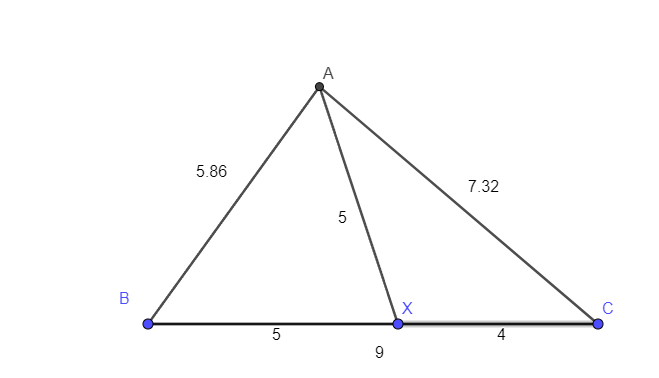Circumradius = product of the sides / [4 * Area]
Since the circumradius of each triangle is the same, then the areas are the same
So this means that we can solve this :
[ AB * AX * BX[ = [ AC * AX * CX]
[AB * 5 * 5 ] = [ AC * 5 * 4 ]
25AB = 20AC
AB = (20 / 25)AC
AB = (4/5)AC
-cos ( AXB) = cos (AXC)
Law of Cosines
AB^2 = BX^2 + AX^2 - 2(BX * AX) cos (AXB)
AC^2 = CX^2 + AX^2 - 2(CX * AX)cos (AXC)
[(4/5)AC]^2 = 5^2 + 5^2 - 2(25) cos (AXB)
AC^2 = 4^2 + 5^2 - 2(20) (-cos AXB)
(16/25)AC^2 = 50 - 50cos (AXB)
AC^2 = 41 + 40cos (AXB)
cos (AXB) = cos(AXB)....so......
[ (16/25)AC^2 - 50 ] / [-50 ] = [AC^2 - 41] / 40
40 [ (16/25)AC^2 - 50 ] = -50 [ AC^2 - 41]
(25.6)AC^2 - 2000 = -50AC^2 + 2050
(75.6)AC^2 = 4050
AC^2 = 4050 / 75.6
AC = sqrt [ 4050 / 75.6 ] ≈ 7.32
AB = (4/5)7.32 = 5.86
Semiperimeter ≈ [ AB + AC +BC ] / 2 = [ 5.86 + 7.32 + 9 ] / 2 = 11.088
[ABC] = sqrt [ 11.088 * ( 11.088 - 5.86) (11.088 - 7.32) (11.088 - 9) ] ≈ 21.36



